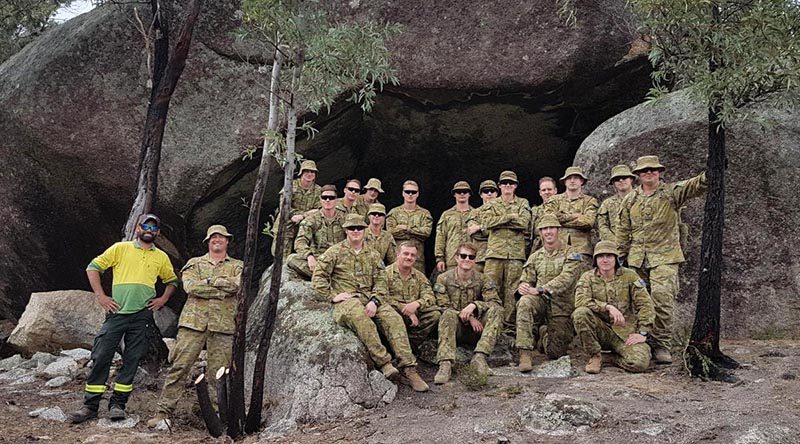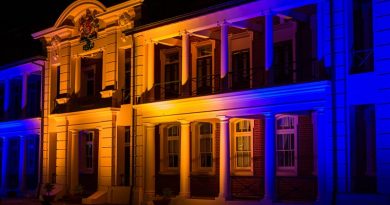Ancient and heritage sites shielded by soldiers
Share the post "Ancient and heritage sites shielded by soldiers"

When Tidbinbilla Nature Reserve staff raced to save some of Australia’s most endangered species from the threat of bushfire in late January, there was little time left to prepare the facilities and historical sites in the reserve.
CAPTION: Soldiers from 6RAR with ACT Parks and Conservation Service Aboriginal field officer Kie Barratt at one of the important heritage sites they helped protect from recent bushfires. Photo by Lieutenant Jack Membrey. Story by Flying Officer Evita ryan.
RELATED STORIES: Operation Bushfire Assist 19-20
With the reserve still under threat from the Orroral Valley Fire in early February, Alpha Company of the 6th Battalion, Royal Australian Regiment (6 RAR), stepped up at the request of the ACT Emergency Services Agency to help prepare key sites in the reserve.
Parks and Conservation Service Ranger John McRae worked with the ESA and said there was no time to prepare for bushfire, only to evacuate the endangered species.
“With the soldiers, we got a lot done in a short space of time, just as it looked inevitable that the reserve was going to be severely impacted by bushfire,” Mr McRae said.
Cleaning up leaf litter, debris and vegetation, 6 RAR created bare earth fire breaks around the buildings and breeding facilities in the reserve, removing anything flammable to reduce the risk of fire damaging the centre.
“They did a fantastic job at the centre,” Mr McRae said.
“I showed the wildlife staff photos of what they’d done and they were very happy.”
6 RAR also prepared the historic Nil Desperandum, a pisé homestead built in the late 1890s that was restored after being damaged by the 2003 bushfires that devastated parts of the ACT.
The homestead’s camellia grove, which is maintained by a volunteer group, took several years to regenerate after the 2003 bushfires.
“The camellia grove is very previous to us,” Mr McRae said.
“It was surrounded by thick bush but the soldiers created a bare earth perimeter around it.
“The homestead is in a remote location and the area is not defendable from bushfires, so this work was just to give it a chance and minimise the risk of damage from bushfires.”
6 RAR also undertook hazard reduction works at two sites of cultural significance to the Ngunnawal people under the guidance of Kie Barratt, an Aboriginal field officer with the ACT Parks and Conservation Service.
“Wallaby Rock is the only known Ngunnawal rock art site in Tidbinbilla Nature Reserve,” Mr McRae said.
“In 2003, the rock art was badly damaged by heat from the bushfires, so the soldiers cut back vegetation that had grown close to the rock.”
On the edge of the reserve is Birrigai Rock Shelter, a significant Ngunnawal site that dates back 25,000 years.
“The soldiers cleaned vegetation from around the shelter and interpretative signage to reduce the risk of fire damaging the rock shelter,” Mr McRae said.
“They did a very good job, hooking in to the work and showing appropriate respect,” Mr Barratt said.
“It was great to see the ADF guys come down for a couple of days to help us protect our assets here at Tidbinbilla, particularly our sacred Ngunnawal sites.
“It made me feel really proud to pass on local knowledge and stories to those guys and to work together to protect those sites for the Ngunnawal mob and future generations.”
Alpha Company Platoon Commander Lieutenant Jack Membrey said the team had been proud to preserve the sites.
.
.
.
.
.
.

.
.
Share the post "Ancient and heritage sites shielded by soldiers"





